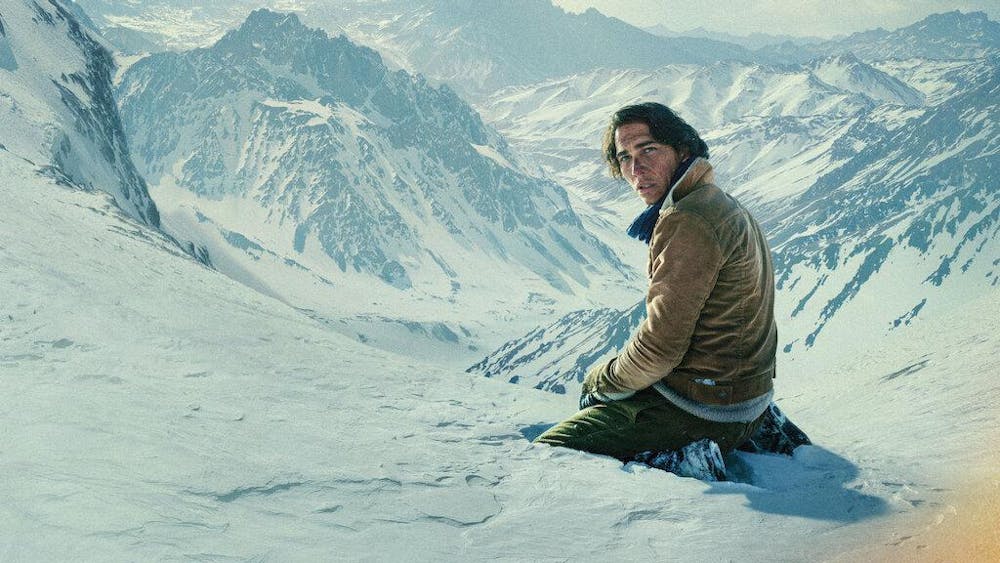On the precipice between life and death, the discoveries one makes about oneself can be earth-shattering. Spanish director J. A. Bayona’s 2023 survival film “Society of the Snow” — adapted from Pablo Vierci’s 2009 book and nominated for “Best International Feature Film” at this year’s Academy Awards — documents the 1972 crash of Uruguayan Air Force Flight 571 in the Andes mountains. Following the survivors of the accident, “Society of the Snow” is an intense and heartbreaking film that viscerally explores the limits of humanity under extreme circumstances.
Covering a historical incident with its tragic outcomes already set in stone, the film derives most of its horror from the way its events are painstakingly dragged out. Its introduction dives directly into the lives of its main ensemble — a rugby team of young men on a final trip to Chile together before the start of their promising futures. Among them is the narrator of the film, Numa Turcatti (Enzo Vogrincic), whose somber voiceover, along with his interactions with his friends, foreshadows what is to come.
When disaster finally strikes, the crash pales in comparison to the atrocities that unfold as a result. Bayona depicts the accident itself with a barrage of harsh sensory details: the plane’s metal frame breaking off in pieces, snow and debris blowing through the air and passengers shrieking as they are catapulted into the mountains. As the initial shock settles in with silent shots of blinding white and close-ups of the men’s faces, a palpable sense of dread is born, one that persists relentlessly throughout the film.
Stretched across a lengthy runtime, the group’s suffering is captured as an excruciating slow burn, conveying a feeling of despair to audience members bearing witness to the carnage. The film gradually takes us into the minds of the hope-deprived survivors, often bringing in philosophical musings on what it means to hold onto one’s humanity when it feels like all meaning has been lost.
The topic of God’s existence and judgment in times of great duress is brought up frequently, as a significant conflict of the film includes the group’s fear of resorting to cannibalism — turning to their companions’ bodies for food once the chances of survival become threateningly slim. This questioning of religion offers a more existential approach to the scenario, which strengthens the film’s realism.
The cinematography of “Society of the Snow” is one of its most exceptional qualities. Making use of various breathtaking long shots of the snowy Andes mountains — unimaginably vast and overpowering in their size — the film underlines the group’s isolation and helplessness against the elements. With the possibility of their voyage to Chile and a return to society lying beyond the ranges, the landscape surrounding the survivors acts as both a representation of hope and a prison.
In one moment of the film, over B-roll footage of the Andes, Turcatti says, “The harder you try to escape, the harder the mountain hits.” While Turcatti’s narration provides deeper insight into the trials of survival, the film emphasizes that rather than a singular main character, the entire cast acts as a collective protagonist in their joint effort to stay alive. Standout figures include teammates Fernando Parrado (Agustín Pardella) and Roberto Canessa (Matías Recalt), whose harrowing journey up the mountain range serves as a crucial part of the film’s narrative. The group’s camaraderie and unwavering will to live are highlighted in as much detail as their agony, and their unity is most closely followed in the film’s final act. All members of the ensemble give their all in expressing their desperation to return home, resulting in a grand emotional payoff at the film’s conclusion.
“I wonder who these pictures are for,” Turcatti narrates in a sequence reflecting on the photographs the group took of each other while stranded — and possibly a reference to the documenting nature of the film itself. “Maybe they’re for our families. Or for other people who are remembering us now. … And when they look at them, we’ll live again in their imaginations.”
Although “Society of the Snow” proves to be a painful and moving account of a superhuman survival story, the film’s main strength is its acceptance of the limitations of capturing the tragedy experienced by the travelers on the Uruguayan plane.
Isabel Hahn is an Arts & Culture editor who concentrates in English and Behavioral Decision Sciences. In her free time, she enjoys watching movies, reading, and journaling.





